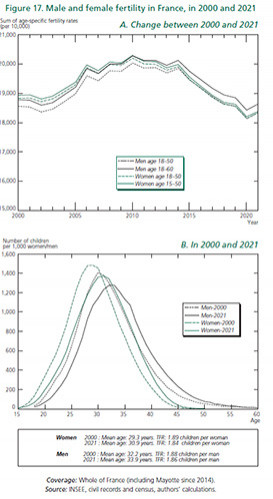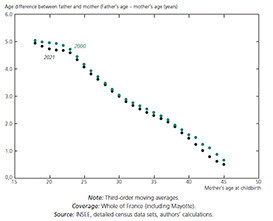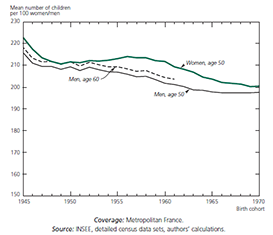Is male fertility higher or lower than female fertility?

INED’s latest article on recent demographic trends in France highlights disparities and indicator trends by sex. One such trend observed by the researchers was men’s fertility compared to women’s. In 2021, on average, men became parents three years later in life than women, a fact that reflects the age difference between the sexes at couple formation. Men’s total fertility rate has been higher than women’s since 2010 (1.87 children as against 1.84 for women in 2021), but the completed fertility of men born in 1961 (1.96) is slightly lower than that of women of the same generation (2.09).
Men’s fertility has pulled ahead of women’s
In France in 2021, the total fertility rate or TFR (obtained by summing single-year age-specific fertility rates at a given time), was 1.87 children per man and 1.84 children per woman (Figure 1A). When measured across the same age range (18-50), men’s fertility has been equal to women’s since 2014. However, for biological and social reasons, men’s and women’s reproductive ages differ. If we consider the entire life period during which a man can potentially have children (ages 18 to 60) and that in which a woman can (ages 15 to 50), we find that male fertility in France first pulled ahead of female fertility in 2010, mainly due to men having children beyond the age of 50. The difference is also explained by the fact that men’s and women’s fertile years do not overlap, meaning that the number of persons in each group at any given time is different. This in turn affects fertility rate calculation.
|
On methodology Demographic situation indicators are based on INSEE’s annual fertility rates by age and by sex. Traditionally, fertility is studied in the female population but it is also possible to calculate men’s fertility. However, because some births records do not reference a father, it is difficult to measure differences in levels of men’s fertility. The proportion of such birth records in France is around 5%. The method used to avoid underestimating men’s fertility is to distribute children whose birth records do not reference a father in accordance with the paternal age distribution for births that do reference a father. Once this has been done, we find that differences by sex subsist. Those differences may be explained by three factors: an imbalance in the ratio of men to women of reproductive age; an age difference at time of union; and a range of variations in fertility and couple formation timing by sex. |
Different fertility profiles
Men’s and women’s fertility profiles differ by age, even at the ages when both sexes are potentially fertile, i.e., between 18 and 50. From 2000 to 2021, male/female age disparity at childbirth remained stable at approximately 3 years. Once again, this is due primarily to age difference upon couple formation. However, male/female age disparity varies with mother’s age at childbirth, attaining nearly 5 years for women who became mothers under the age of 20, but rising—and approaching 0—with mother’s age at childbirth (Figure 2). The age difference between parents at the birth of their child has fallen slightly in France since 2000, for all ages. For men and women alike, the trend in fertility profiles by age over the last twenty years is marked by having children later in life and a declining birth rate (Figure 1B).
Unknown long-term effects
It is hard to predict the long-term effects of having children later in life: postponing parenthood does not necessarily reduce a person’s completed fertility, i.e., the total number of children they have while fertile, and this is especially true for men, who are under fewer biological constraints than women. While we can compare the completed fertility levels of men and women in the 1961 cohort—1.96 children per man and 2.09 per woman (Figure 3)— men born in 1970 may well not have completed their fertility: some will have children beyond age 50. And at that age, in France, after the 1960 cohort, the disparity between men’s and women’s already achieved fertility decreases. Only time will tell whether the completed fertility of men born in the early 1970s will be equal to—if not higher than—the fertility of women of the same generations.



Source : Didier Breton, Nicolas Belliot, Magali Barbieri et al., 2023, L’évolution démographique récente de la France : Les comportements des femmes et des hommes sont-ils si différents ? Population (French edition) 78: 1-68
Article on open access in a scientific journal referenced by evaluation bodies working to ensure the quality and integrity of published scientific research
On line:January 2024
